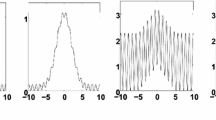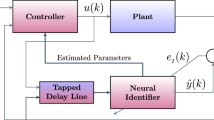Abstract
This paper introduces a novel approach to the design of the feedback linearization called the learning feedback linearization (LFL) method. This method is used to learn the feedback linearization input for a nonlinear plant. The control scheme of the LFL method, which is devised by one artificial neural network (ANN) block, is based on a nonlinear auto regressive moving average model. The LFL method training phase uses not only input-output data pairs of the nonlinear plant but also a generated sequence data obtained from the states of the nonlinear plant. After the training phase of the LFL, a conventional proportional-integral controller is chosen as a linear controller for the feedback linearized closed-loop system. The performance of the developed ANN based LFL method is tested for tracking control problems via mean square error during the training and the test phases. The developed method is applied on both a nonlinear exponential plant and a well-known flexible joint mechanism plant in real-time simulation mode.










Similar content being viewed by others
References
Doyle FJ III (1999) An anti-windup input–output linearization scheme for SISO systems. J Process Control 9(3):213–220
Slotine JJE, Li W (1991) Applied nonlinear control. Prentice Hall, Upper Saddle River
Lewis FW, Jagannathan S, Yesildirek A (1999) Neural network control of robot manipulators and non-linear systems. Taylor Francis, Philadelphia
He S, Unbehauen R (1998) Approximate feedback linearization using multilayer neural networks. Neural Process Lett 8(2):131–144
He S, Reif K, Unbehauen R (1998) A neural approach for control of nonlinear systems with feedback linearization. IEEE Trans Neural Netw 9(6):1409–1421
Qu D, Tang D (2010) On control structure scheme of feedback linearization for nonlinear system based on ANN models and simulation researches. In: 3rd international congress on image and signal processing (CISP), vol 8(1), 16–18 Oct, pp 3645–3649
Narendra KS, Mukhopadhyay S (1997) Adaptive control using neural networks and approximate models. IEEE Trans Neural Netw 8(3):475–485
Deng H, Li HX, Wu YH (2008) Feedback-linearization-based neural adaptive control for unknown nonaffine nonlinear discrete-time systems. IEEE Trans Neural Netw 19(9):1615–1625
Pedro JO, Dahunsi OA (2011) Neural network based feedback linearization control of a servo-hydraulic vehicle suspension system. Int J Appl Math Comput Sci 21(1):137–147
Hagan MT, Demuth HB, Jesús OD (2002) An introduction to the use of neural networks in control systems. Int.J Robust Nonlinear Control 12:959–985
Zhang G, Shen Y (2014) Exponential synchronization of delayed memristor-based chaotic neural networks via periodically intermittent control. Neural Netw 55:1–10
Zhang G, Shen Y (2013) New algebraic criteria for synchronization stability of chaotic memristive neural networks with time-varying delays. IEEE Trans Neural Netw Learn Syst 24:1701–1707
Lu Z, Shieh LS, Chen G, Coleman NP (2006) Adaptive feedback linearization control of chaotic systems via recurrent high-order neural networks. Inf Sci 176(16):2337–2354
Moradi M, Malekizade H (2013) Neural network identification based multivariable feedback linearization robust control for a two-link manipulator. J Intell Robot Syst 72(2):167–178
Astrom KJ, Hagglund T (1995) PID controllers: theory, design, and tuning, 2nd edn. Instrument Society of America, Research Triangle Park
Şahin S, Işler Y, Güzeliş C (2010) A microcontroller based test platform for controller design. In: IEEE international symposium on industrial electronics (ISIE), pp 36–41
Spong MW (1995) Adaptive control of flexible joint manipulators: comments on two papers. Automatica 31(4):585–590
Şahin S (2010) Nonlinear dynamical state feedback design for tracking and chaotification. PhD Thesis, Graduate School of Natural and Applied Sciences, Dokuz Eylül University
Astrom KJ, Wittenmark B (1994) Adaptive control. Addison-Wesley, Longman Publishing Co., Inc., Boston
Sastry S (1999) Nonlinear systems analysis, stability and control. Springer-Verlag NY, Inc, New York
Grizzle JW (1986) Feedback linearization of discrete-time systems. Anal Optim Syst 83:273–281
Ölmez M, Güzeliş C (2015) Exploiting chaos in learning system identification for nonlinear state space models. Neural Process Lett 41(1):29–41
Acknowledgments
This work was supported in part by the Scientific Research Projects Office of İzmir Katip Çelebi University under Grant BAP-2013-1- FMBP-09 and in part by the Scientific and Technological Research Council of Turkey under Grant 114E432.
Author information
Authors and Affiliations
Corresponding author
Rights and permissions
About this article
Cite this article
Şahin, S. Learning Feedback Linearization Using Artificial Neural Networks. Neural Process Lett 44, 625–637 (2016). https://doi.org/10.1007/s11063-015-9484-8
Published:
Issue Date:
DOI: https://doi.org/10.1007/s11063-015-9484-8




